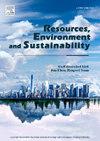Electric-field-induced assists in the preferential extraction of lithium from spent LiFePO4
IF 12.4
Q1 ENVIRONMENTAL SCIENCES
引用次数: 0
Abstract
Due to the advantages of high energy density, high conversion efficiency, and rapid response speed associated with power lithium batteries, there has been a significant expansion in their use. However, industry forecasts indicate that if large quantities of waste lithium-ion batteries are not managed properly, it could lead to serious environmental pollution issues as these batteries reach the end of their life cycle. Therefore, developing highly efficient and environmentally friendly recycling technologies is urgently needed. This paper proposes a green and efficient selective lithium extraction process integrating leaching technology with electrochemical methods. This approach enables the separation of Li and FePO4 within an electrolyte through electric field assistance while effectively minimizing waste liquid generation. The effects of various factors on Li and Fe’s leaching rates were investigated using orthogonal and single factor experiments. Under optimal conditions, the leaching rate of Li reached 98.85%, while that for Fe was only 0.22%, resulting in a selectivity ratio (Li/Fe) of 99.78%, which demonstrates successful selective extraction of lithium. Furthermore, we assessed the feasibility of this experiment through potentiometric-pH diagrams. We elucidated its mechanism using XPS, XRD, and SEM. Unlike conventional destructive leaching methods, the Li extraction process facilitated by the electric-field-induced assistance resembles the charging process of LiFePO4 batteries. Ultimately, Li was recovered as Li2CO3, while Fe and P present in the slag were subsequently retrieved as FePO4 with battery-grade purity through a hydrothermal method. This study presents an environmentally sustainable and economically viable approach for recovering spent LiFePO4 batteries.

电场诱导有利于从废LiFePO4中优先提取锂
由于动力锂电池具有能量密度高、转换效率高、响应速度快等优点,其应用得到了显著的扩展。但是,业界预测,如果对大量废弃锂离子电池管理不当,可能会导致严重的环境污染问题,因为这些电池将达到其生命周期的终点。因此,迫切需要开发高效环保的回收技术。本文提出了一种将浸出技术与电化学技术相结合的绿色高效的选择性提锂工艺。这种方法可以通过电场辅助在电解质中分离Li和FePO4,同时有效地减少废液的产生。采用正交试验和单因素试验研究了各因素对锂、铁浸出率的影响。在最优条件下,锂的浸出率可达98.85%,而铁的浸出率仅为0.22%,选择性比(Li/Fe)为99.78%,表明锂的选择性提取成功。此外,我们通过电位- ph图评估了该实验的可行性。利用XPS、XRD、SEM等手段对其机理进行了分析。与传统的破坏性浸出方法不同,电场诱导辅助下的锂提取过程类似于LiFePO4电池的充电过程。最终,Li被回收为Li2CO3,而存在于炉渣中的Fe和P随后通过水热法回收为电池级纯度的FePO4。本研究提出了一种环境可持续和经济可行的回收废旧磷酸铁锂电池的方法。
本文章由计算机程序翻译,如有差异,请以英文原文为准。
求助全文
约1分钟内获得全文
求助全文
来源期刊

Resources Environment and Sustainability
Environmental Science-Environmental Science (miscellaneous)
CiteScore
15.10
自引率
0.00%
发文量
41
审稿时长
33 days
 求助内容:
求助内容: 应助结果提醒方式:
应助结果提醒方式:


